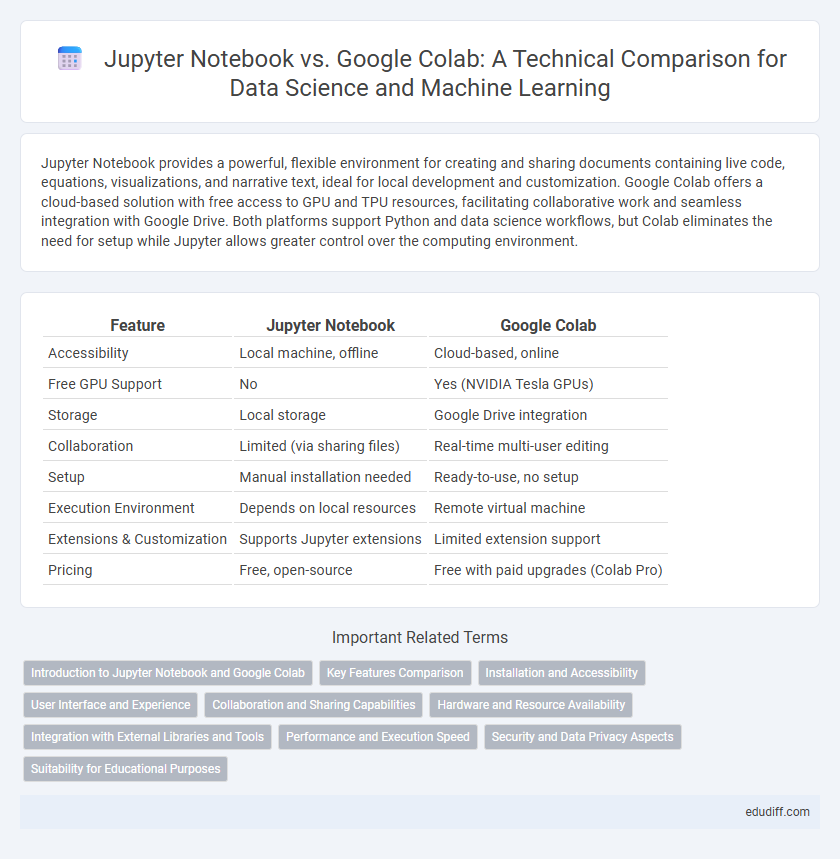Jupyter Notebook provides a powerful, flexible environment for creating and sharing documents containing live code, equations, visualizations, and narrative text, ideal for local development and customization. Google Colab offers a cloud-based solution with free access to GPU and TPU resources, facilitating collaborative work and seamless integration with Google Drive. Both platforms support Python and data science workflows, but Colab eliminates the need for setup while Jupyter allows greater control over the computing environment.
Table of Comparison
| Feature | Jupyter Notebook | Google Colab |
|---|---|---|
| Accessibility | Local machine, offline | Cloud-based, online |
| Free GPU Support | No | Yes (NVIDIA Tesla GPUs) |
| Storage | Local storage | Google Drive integration |
| Collaboration | Limited (via sharing files) | Real-time multi-user editing |
| Setup | Manual installation needed | Ready-to-use, no setup |
| Execution Environment | Depends on local resources | Remote virtual machine |
| Extensions & Customization | Supports Jupyter extensions | Limited extension support |
| Pricing | Free, open-source | Free with paid upgrades (Colab Pro) |
Introduction to Jupyter Notebook and Google Colab
Jupyter Notebook is an open-source web application that allows users to create and share documents containing live code, equations, visualizations, and narrative text, widely used for data analysis and machine learning. Google Colab provides a cloud-based Jupyter Notebook environment with free access to GPU and TPU resources, enabling seamless collaboration and execution without local setup. Both tools support Python and offer interactive computing environments, but Colab integrates directly with Google Drive for storage and sharing.
Key Features Comparison
Jupyter Notebook offers a fully customizable local environment with extensive support for various programming languages and offline accessibility, making it ideal for tailored data science workflows. Google Colab provides seamless cloud-based collaboration, free GPU/TPU access, and automatic integration with Google Drive, enhancing productivity for team projects and machine learning tasks. Both platforms support interactive coding, data visualization, and markdown documentation, but Colab's cloud infrastructure simplifies sharing and resource management compared to Jupyter's standalone setup.
Installation and Accessibility
Jupyter Notebook requires local installation of Anaconda or Jupyter packages, which demands configuring Python environments and dependencies, making it suitable for users with dedicated hardware and software control. Google Colab, accessible via any web browser, eliminates installation barriers by offering a cloud-based platform with pre-installed libraries and GPU support, enhancing accessibility for collaborative and remote work. This cloud-hosted nature allows seamless access from multiple devices without hardware limitations.
User Interface and Experience
Jupyter Notebook offers a highly customizable user interface that supports interactive data visualization and inline code execution, enhancing user control over their environment. Google Colab provides a cloud-based experience with pre-configured resources, seamless GPU access, and easy collaboration features, streamlining the workflow for users without requiring local setup. Both platforms emphasize notebook-style coding, but Colab's integration with Google Drive and real-time sharing improves accessibility and user experience for team projects.
Collaboration and Sharing Capabilities
Google Colab excels in collaboration by enabling real-time multi-user editing and seamless integration with Google Drive for effortless sharing of Jupyter notebooks. Jupyter Notebook requires manual sharing methods like exporting files or using version control platforms such as GitHub, which can complicate simultaneous collaboration. Colab's cloud-based environment simplifies access and sharing, making it ideal for teams working remotely on data science projects.
Hardware and Resource Availability
Jupyter Notebook primarily relies on local machine hardware, making its performance dependent on the user's CPU, RAM, and GPU capabilities, which can limit scalability for large datasets or complex models. Google Colab provides cloud-based hardware access, including free usage of GPUs like NVIDIA Tesla K80, T4, and P100, offering enhanced computational power without local resource constraints. Resource availability on Google Colab is managed through session limits and usage quotas, while Jupyter offers unlimited usage constrained only by the user's own hardware capacity.
Integration with External Libraries and Tools
Jupyter Notebook offers seamless integration with a wide array of external libraries and tools through direct installation in the local environment, granting full control over package versions and dependencies. Google Colab provides pre-installed popular libraries and supports easy installation of additional packages but can face limitations due to its cloud-based environment and ephemeral sessions. Both platforms enable integration with external APIs and data sources, yet Jupyter's local setup often allows more robust customization and persistent configurations for advanced data science workflows.
Performance and Execution Speed
Jupyter Notebook runs locally, leveraging the user's hardware resources, which can lead to faster execution for tasks dependent on CPU and RAM capacity. Google Colab provides access to free cloud-based GPUs and TPUs, significantly accelerating machine learning model training and large data processing compared to typical local setups. Execution speed in Colab can be affected by internet latency and shared resource limitations, while Jupyter Notebook performance depends directly on the local machine's specifications.
Security and Data Privacy Aspects
Jupyter Notebook operates locally, offering users full control over data security and privacy by restricting access to their own machines and networks. Google Colab stores notebooks and data in the cloud, requiring consideration of Google's data handling policies and potential exposure risks associated with cloud storage. Encryption protocols and user authentication methods in both platforms critically impact the protection of sensitive information during interactive computing sessions.
Suitability for Educational Purposes
Jupyter Notebook offers extensive customization and offline access, making it ideal for educational environments with limited internet connectivity and requiring deep interaction with local resources. Google Colab provides seamless cloud-based collaboration, automatic hardware acceleration, and effortless sharing, enhancing real-time group projects and remote learning scenarios. Both platforms support Python and rich media integration, but Google Colab's integration with Google Drive and simplified setup makes it more suitable for students and educators seeking a user-friendly, scalable solution.
Jupyter Notebook vs Google Colab Infographic

 edudiff.com
edudiff.com